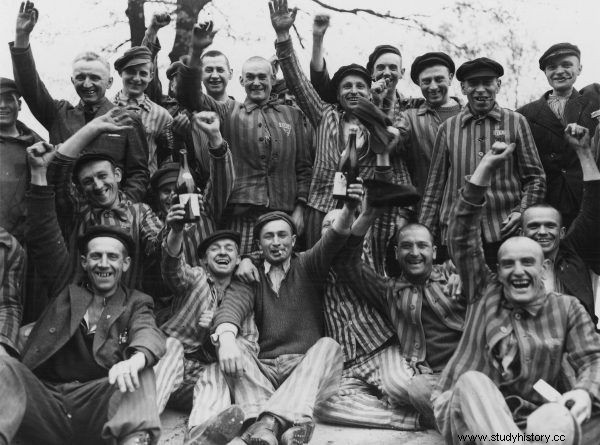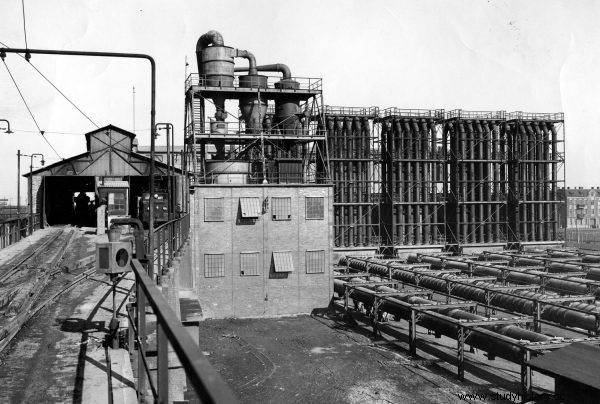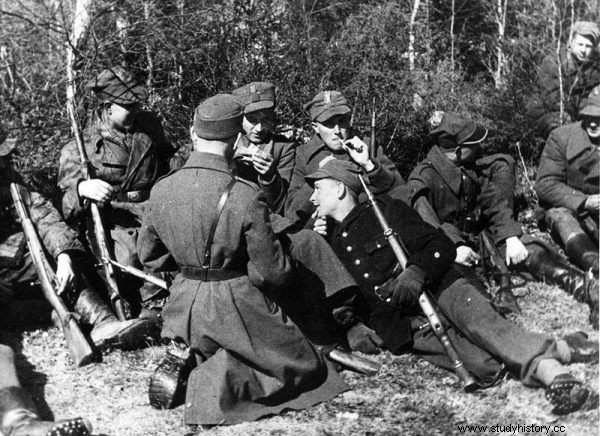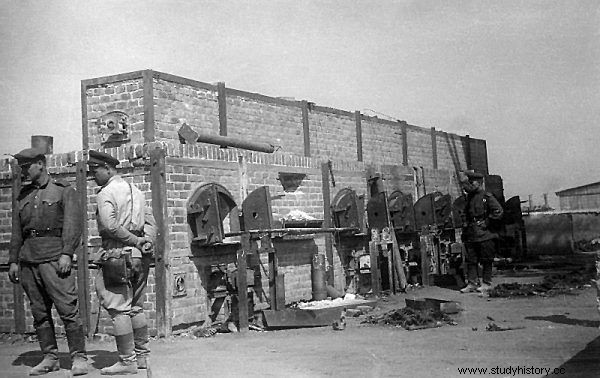Propaganda films, manipulated series, book peans. For half a century, the people's government did everything to instill in Poles undying gratitude for being freed from German occupation. Millions still see liberators in the Red Army. What was the reality like?
1. They saved in the morning, raped at night
When Bożena Kozłowska from Anina near Warsaw saw the first soldier, tears flowed from her eyes. She couldn't believe that the occupation was over. That freedom and security will return. Joy quickly turned to consternation. The soldier kept asking for vodka. As she recalled: Germans always asked for water .
That day, the same soldier visited her once more. This time he was very drunk and he came with a companion. They tried to rape her and her sister. The women were saved only thanks to the intervention of a few soldiers of the Polish People's Army.
Lured by the shouts of the sisters, they ruthlessly dragged the would-be rapists out of the house. However, this was only an exception to the rule. Most often, the victims turned out to be defenseless, and the soldiers only helped each other in the crime. The case from Pińczów is characteristic here:
I report that on the night of 26/27 bm. [19] In 45, two Russian soldiers entered the city. After the incursion, these soldiers terrorized me, putting weapons to my head and threatening to transport me to Russia (...). These soldiers claimed that they had been fighting for Poland for the third year, so they had the right to all Polish women, and that they had come here on the command of the commander. (...) began to terrorize their wife by putting a revolver to her mouth, kicking her, pulling her hair and categorically demanding that their daughters be returned. When the wife declared that she would absolutely not give up her daughters, they pulled her by the hair and dragged her out into the yard from the apartment, where they brutally threw her to the ground and raped her.

Red Army soldiers raped tens of thousands of Polish women.
2. Red Army soldiers robbed Poles and plundered their homes already at the time of "liberation"
The Majkowski family, residents of the Kashubian village of Skrzeszewo, saw it personally. They were just at home when a detachment of Soviet cavalrymen came to their farmyard. After a warm welcome, the Poles were horrified to discover that in the meantime the Soviet soldiers had managed to lead them out of the stables with a mare with a foal.
The family senior also lost his watch and wedding ring. When the Red Army finally left, the Majkowskis remained barefoot in the yard of their homestead, wearing only their underwear - they were "liberated" from shoes and sheepskin coats. Marian Majkowski said: This was the beginning on the first day of freedom, the new eastern freedom . At least he could be glad he had survived. Many Poles did not have the opportunity to enjoy freedom from Nazism. In the protocols of the Krakow Forensic Medicine Institute in 1945, it was noted:
Szymon Piekarczyk - "shot at night by Soviet soldiers on ul. Prandoty ";
Zdzisław Walczyk - "murdered by N.N. individuals in uniforms of the Soviet Army in a stonemason's workshop ”;
Paweł Kucharski - "At 0.30 am several Soviets burst into the apartment for robbery, who fired a fatal shot at the deceased, dragging him out into the yard";
Find out the truth about the alleged liberation of the Polish-Lithuanian Commonwealth in the book "Red Plague":
Zbigniew Leja, a policeman "shot on the road in Borek Fałęcki by the Soviets, going to help people robbed by them";
Józef Magda "robbed and shot by Soviet soldiers";
Ludwik Kózka "left in his own car, attacked by the Soviets on the way, robbed and shot".
3. The Krasnoarmeys confiscated food en masse, completely ignoring the needs of the Poles
Stefania Pepławska from Kolonia Chotum near Ciechanów witnessed this behavior of the Soviet units. She recalled how the "liberating" Red Army in January 1945 took the last pigs from her parents' farm. Soldiers looted all the surrounding villages in a similar way, leaving their inhabitants exposed to hunger.
All this happened in the majesty of the law established by the new, supposedly Polish government. At the beginning of February 1945, the communist authorities of Poland undertook to provide 150,000 to the needs of the Soviet army. tons of grain, 250 thousand. tons of potatoes, 100 thousand. tonnes of straw and hay, and until July 1 also 25 thousand. tons of meat. According to estimates at that time, we were forced to give over 30% of the estimated grain resources, 25% of potatoes, over half of Polish meat and over 66% of straw and hay to the "allies" from the East!

They are happy and smiling in their company. They had no qualms towards the Poles.
Red Army soldiers did not pay for the confiscated goods and usually did not even try to get any receipts so that the Poles could later pursue their claims. In our country, stories are told about how the Soviet soldiers stole the last chickens from Polish families. In fact, it was so, in thousands of households.
4. Even the rank and file of the Red Army completely disregarded the Polish authorities
For example, the starost of the Kamieniogóra poviat (now Kamienna Góra) experienced ill-treatment by Soviet soldiers. He was arrested by the Red Army soldiers while trying to reach the place of the murder of an officer of the Citizens' Militia. No explanations on his part that he was a representative of the Polish authorities helped.
One of the boyfriends then said a vulgar remark at him:. The Soviet commander in the same town said:"If you Polish women do not stop interfering with us, we will organize ourselves, we will disarm you and shoot you like dogs."
5. In the "regained territories" they harassed and discriminated against Poles, singling out the Germans
This was the case, for example, in Wrocław, where the Soviets based their administration on German officials, many of whom until recently served Hitler faithfully. The German mayor even ordered posters to be displayed, summoning all Poles and Jews in the city to report to the offices for the purpose of job assignments!

In the regained territories, the Soviets distinguished the Germans, often discriminating against and even harassing Poles. The photo shows the destruction of Wrocław cathedral and its surroundings in 1945.
Only the arrival of the Polish mayor, Bolesław Drobner, put an end to this Soviet-German self-government in Wrocław. He immediately ordered the arrogant German to be arrested. Also, the omnipotent Soviet commanders did not have an easy life with Drobor. Quarrels between them were the order of the day, and the Pole did his best to put an end to Soviet lawlessness in the city. And he constantly encountered resistance from our "friends" in the East.
6. They robbed prisoners and forced laborers returning from Germany, including their own countrymen
There was no sanctity for Stalin's soldiers. They even attacked people who had gone through the ordeal in concentration camps. A minor prisoner of Buchenwald, Wiesława Chełmińska-Rupiewicz, was robbed by a Soviet officer of all her belongings at the Warsaw West Station. It was May 1945. The degenerate left her in her underwear and tried to shoot her again.
In turn, the Soviet war correspondent, Vasily Grossman, in conquered Poznań, encountered 250 emaciated, young Ukrainian women. These women were in a terrible condition:almost naked, lice-laden and starving. As it turned out later, until the Soviet troops entered the city, they looked quite normal. Only the people who came to liberate them took everything from them.

The liberated prisoners of the German camps had to confront the new Soviet reality.
6. They committed mass rapes of female prisoners and forced laborers returning to Poland.
Particularly tragic was the fate of the women who spent the war in Germany - as prisoners of camps or forced laborers. They were threatened not only with robberies, but also with the most heinous acts of sexual violence. In May 1945, representatives of the State Repatriation Office in Stargard stated that only a few women avoided rape by the Red Army soldiers. Janina Zając, returning home, described the terrifying scenes. Together with their traveling companions, they hid from the Soviets in a certain apartment. As she mentioned, "we were scared of ourselves there."
The girls were lucky not to be noticed. However, he was missing a Polish family in the neighboring room - a married couple with a three-week-old child and the parents of one of them. The young mother was so brutally raped all night long that she died in the morning.
8. They dismantled and transported over a thousand industrial plants from Poland
According to Soviet sources (sic!), 1119 enterprises were dismantled and deported by the "liberators" in today's territory of Poland. Thousands of kilometers of railway, electric and telephone lines, countless amounts of raw materials, means of transport, agricultural produce, cattle, pigs have also fallen prey to them ... Until January 1, 1948, no less than 283,000 wagons with prey left our eastern border.

The Soviets deported over a thousand industrial plants from post-war Poland.
On the Oder, the Soviets confiscated 98% of the river fleet. In port cities, 70% of shipbuilding assets passed into the possession of the "allies". And this is by the decision of the State Defense Committee. From the factories of Upper Silesia alone, in March 1945, 26,000 people were destined for removal. tons of rolled products, 4 thousand. tons of various metal products, 3 thousand. tons of sheet metal, 2 thousand. tons of steel pipes, 560 tons of steel ropes and 2.4 tons of silver. And similar numbers can be exchanged almost endlessly! No wonder, because as many as 80,000 soldiers served in the "trophy otriads", i.e. robbery units of the Stalinist army.
The value of confiscation and damage in pre-war areas caused by the Soviet army alone was calculated by the communist authorities of Poland at at least PLN 2.67 billion. Additionally, there are losses in infrastructure, residential buildings and unregulated costs related to the operation of the Soviet garrisons in Poland. The value of these losses is as high as $ 54 billion today. And this is an extremely careful estimate!
9. They deceitfully disarmed and arrested the soldiers of the Home Army who had previously seized Polish cities from the hands of the Germans
It happened so, inter alia, with units of the Home Army in Vilnius and Lviv. In Skrobów, on 25 July 1945, Soviet units surrounded the soldiers of the 27th Volhynian Division of the Home Army. Poles were lured there to allegedly inspect the troops before their joint march to Warsaw. The same fate befell the soldiers of the 3rd, 8th, 9th and 26th Infantry Divisions of the Home Army, numbering a total of 6,000 people.

The Soviets deceitfully disarmed and arrested the Home Army soldiers who had previously seized Polish cities from the hands of the Germans. The photo shows the soldiers of the 27th Volhynian Infantry Division of the Home Army.
Some of them, together with the Red Army, conquered Minsk Mazowiecki, Sokołów, Radzymin, Tłuszcz and Węgrów. In Dębie Wielki, on August 19, the soldiers of the 30th Infantry Division of the Home Army were disarmed on their way to the fighting Warsaw. According to the orders of the Soviet command, all detained Poles were to be treated as prisoners of war. However, they were often treated worse than criminals.
The events that took place in the Vilnius Region are particularly characteristic. Already in mid-1943, the Soviets proposed our joint action. To discuss the details, the commander of the Home Army unit went to the communist camp. Staff officers accompanied him. On the spot, the Poles were arrested immediately. A few Soviet apparatchiks then arrived at the Polish base.
The accidents happened quickly. Lidia Lwow, who was in the Home Army division at the time, remembered those events as follows:
At about one o'clock our base was surrounded by Soviet guerrillas and our unit was disarmed. Some commissioner spoke, said that nothing would happen to anyone, that it would still be a Polish unit, even under Polish command, but under communist command, and under Soviet authority.

More about the activities of the Red Army on Polish soil in the newest book by Dariusz Kaliński, "Dariusz Kaliński" Red pest. What did the liberation of Poland really look like ".
On the next day, Colonel Fyodor Markow himself came to the Poles. Akowski partisans were divided. About 50 Poles were shot, 80 were released to their homes after disarmament, and out of the remaining 70, a "people's" unit was created. The latter, however, quickly escaped and joined the ranks of Home Army units again. There were countless such cases of betrayal. In one of the Soviet orders, from December 1943, it was written:"Resistance legionnaires-partisans, be shot on the spot while disarming."
10. In Poland, they created a network of camps through which even 100,000 people passed. Poles
In the years 1944–1945, the Soviet security department inspected over a hundred such facilities in our country. They can be called labor camps, but those who compare them with concentration camps will not be mistaken either. Especially that they were often built in the same places, and the Reds used barracks erected by the Germans. Nearly half of the people imprisoned in the Soviet camps belonged to the Home Army and other underground underground organizations. Among them were also members of the Polish state administration (starosts, mayors, village heads), postal workers, railroad workers, foresters ... In a word, all people, at least potentially hostile to the "new" Poland.
The German death camp at Majdanek, where the Nazis murdered about 80,000. people, was seized by soldiers of the Red Army on July 23, 1944, and quickly passed into the hands of the NKVD. Two weeks later, new prisoners were detained there - probably on August 8, officers from the 3rd Infantry Division of the Home Army were sent to the camp. Then came more. It was, among others command of the 27th Volhynian Infantry Division of the Home Army disarmed by the Soviets and the 30th Poleska Infantry Division of the Home Army, going to the rescue of fighting Warsaw. At Majdanek there were also officers of the District Command of the Home Army in Lublin and Lviv, as well as Polish policemen cooperating with the Home Army and representatives of the Provisional Substitute Administration.

Red Army soldiers in the liberated Majdanek camp. Barely a few weeks later, the NKVD put Polish patriots in him.
Inmates were kept in two windowless, infested barracks. Wooden bunks were used for sleeping, and German military coats were used as bedding. Soldiers were allowed to leave the buildings, which aroused the understandable interest of visitors to the former German camp. When asked who they were, Soviet guards invariably replied that they were collaborators of the Third Reich.
Encouragements quickly developed Oświęcim and Działdowo. It was almost like during the German occupation:watchtowers, barbed wire fences, dogs. Only the "tenants" and watchmen have changed. The latter were now armed with pepeses. No one made any medical experiments on prisoners and no one gassed them with a cyclone, but people died in alarming numbers anyway.
Other Soviet camps operated in Białystok, Bielsko, Blachownia, Brześć nad Bugiem, Bytom, Chełmno, Ciechanów, Działowo, Dęblin, Działdowo, Elbląg, Gorzów Wielkopolski, Grabów, Grudziądz, Hrubieszów, Inowrocław-Mątwach, Iławierzy, Katowice, Katowice Kętrzyn, Kijany, Krasków, Krzesimów, Krześlin, Krzystkowice, Lędziny, Lipno, Łęgnowo, Majdanek, Łabędach, Mysłowice, Nakło nad Notecią, Opole, Ostrów Mazowiecka, Otwock, Oświęcim, Piła, Poznań, Poniatowa, Przemyśluice, Pustków, Racokowice , Rembertów, Ryki, Sanok, Sępolno Krajeński, Skopanie, Skrobowie, Skrudowie, Sokołów Podlaski, Sokółka, Starogard, Świętoszów, Wągrowiec, Wrocław, Toruń, Toszek, Trzcianka, Warsaw, Wołkowyskach, Zabrze, Zdzieszowice, Zimnych Wodki ... to, they are the ones that best symbolize the friendship and liberation coming from the East.
***
You can read more about the Soviet "liberation" of Poland in the book by Dariusz Kaliński entitled "The Red Plague"
Find out the truth about the alleged liberation of the Polish-Lithuanian Commonwealth in the book "Red Plague":
